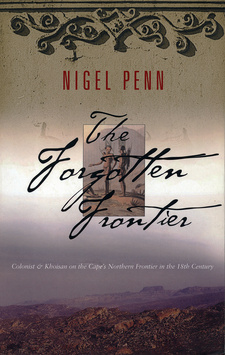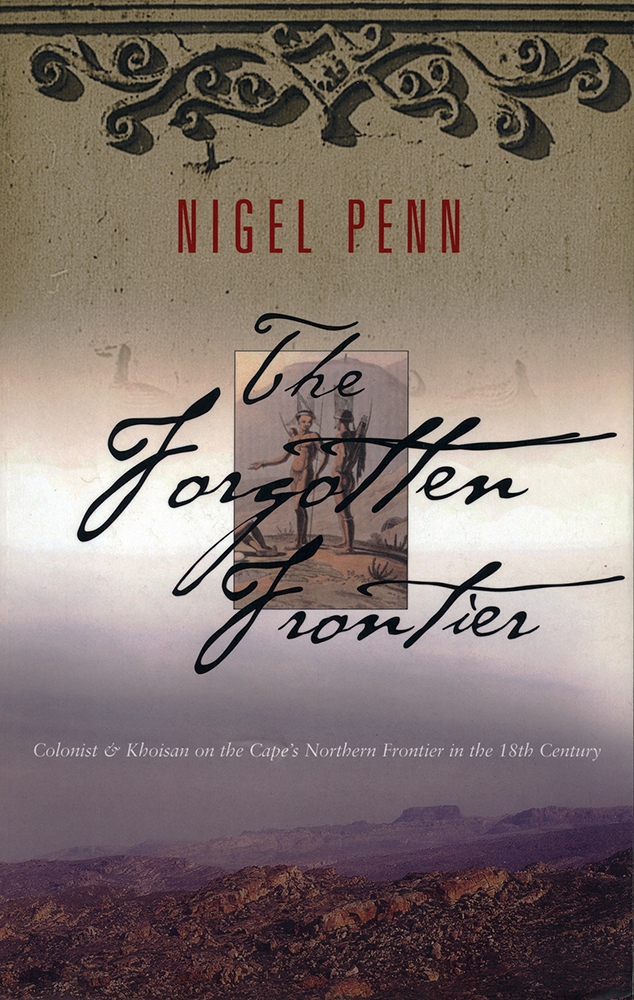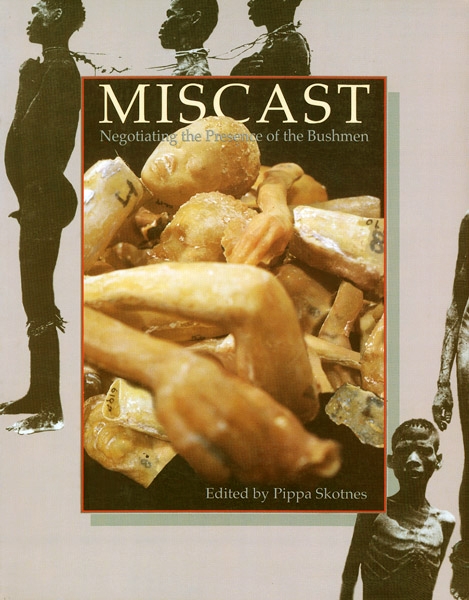The Forgotten Frontier. Colonists & Khoisan on the Cape’s northern frontier in the 18th century, by Nigel Penn

The Forgotten Frontier. Colonists & Khoisan on the Cape’s northern frontier in the 18th century, by Nigel Penn. Double Storey Books. Cape Town, South Africa 2005. ISBN 1770130268 / ISBN 1-77-013026-8 / ISBN 9781770130265 / ISBN 978-1-77-013026-5
When Nigel Penn first began work on The Forgotten Frontier - Colonists & Khoisan on the Cape’s northern frontier in the 18th century, the most important question in his mind was, 'What happened to the Khoisan societies of the Cape?'
It was clear to me that the answer was to be found in the crucial years of the eighteenth century, during which time Dutch colonists advanced into the Cape interior and confronted the Khoisan with a decisive challenge: submit, retreat or perish. I discovered that there was no detailed or satisfactory account of this seemingly central episode in South African history. The majority of historians, if they noticed the process of colonial conquest at all, were quick to anchor their narratives to the drama of the eastern frontier, where the conflict between the Xhosa and the colonists after 1770 seemed to be of overriding importance. The history of Khoisan-colonial contact between 1700 and 1770 was a virtual blank and, post-1770, was treated largely as a side-show of the eastern frontier. Confronted with the task of rectifying this omission, I decided to concentrate on the little-known northern frontier zone and leave the eastern frontier to others. The paucity of historical commentary and secondary material forced me to start my enquiry almost from scratch. I was keen to consider both sides of the frontier, and attempt to recover the neglected experience of the Khoisan as well as that of the better-documented colonists. My starting point would therefore have to be a study of the precolonial Khoisan, and the acquisition of knowledge of the terrain and environment in which they had lived. Thanks to the generous enthusiasm of members of the Spatial Archaeology Research Unit at the University of Cape Town, I was able to go some way towards realising these ambitions. I have no qualms about including archaeological evidence amongst my sources - stone, bone and rock paintings also tell stories to the skilled reader -and much in this book concerning the Cape Khoisan has been learnt from my archaeological mentors during the course of numerous discussions and on a variety of field trips. But it was by enabling me to spend time in the outdoors that the archaeologists gave me access to the most valuable primary resource of all - the land itself. Thanks to them, I have spent many days contemplating the various environments described in this thesis: the boiling sand of the Sandveld; the fragrant fynbos of the Cape Fold Mountains; the parched plains of the Tanqua Karoo; the sombre ridges of the Roggeveld escarpment; the flower-strewn semi-deserts of Namaqualand; the tragic melancholy of empty Bushmanland; and the long, strong waters of the Orange River. Without such knowledge this account would have lacked an important dimension. It was clear, however, that I would also have to immerse myself in the historical records of the eighteenth-century Cape colony under the Dutch East India Company (VOC). Of particular relevance were those records that dealt with the northern frontier zone, a region which, during the eighteenth century, fell under the jurisdiction of the landdrost of Stellenbosch. Since the records are in archaic Dutch, I had to learn how to understand them, a process involving both translation of language and interpretation of content. My first task, that of translating or comprehending the Dutch, was achieved more by a process of osmosis and endurance than by linguistic skill. [..]
This is an excerpt from: The Forgotten Frontier. Colonists & Khoisan on the Cape’s northern frontier in the 18th century, by Nigel Penn.
Title: The Forgotten Frontier
Subtitle: Colonists & Khoisan on the Cape’s northern frontier in the 18th century
Author: Nigel Penn
Publisher: Double Storey Books
Cape Town, South Africa 2005
ISBN 1770130268 / ISBN 1-77-013026-8
ISBN 9781770130265 / ISBN 978-1-77-013026-5
Softcover, 15 x 23 cm, 400 pages, 8 maps
Penn, Nigel im Namibiana-Buchangebot
The Forgotten Frontier. Colonists & Khoisan on the Cape’s northern frontier in the 18th century
The Forgotten Frontier. Colonists & Khoisan on the Cape’s northern frontier in the 18th century: What happened to the Khoisan societies of the Cape?
Miscast. Negotiating the Presence of the Bushmen
Miscast: Negotiating the Presence of the Bushmen explores the term "Bushman" and the relationships that gave rise to it.


